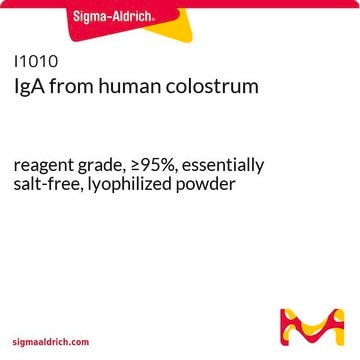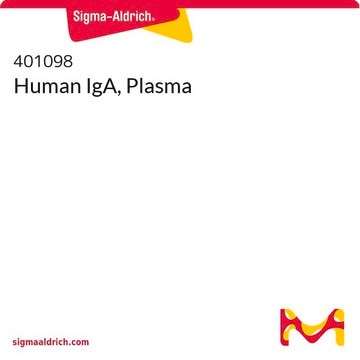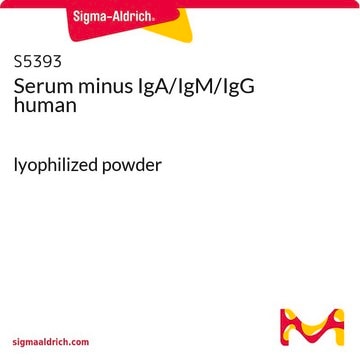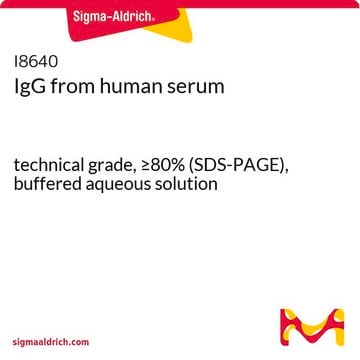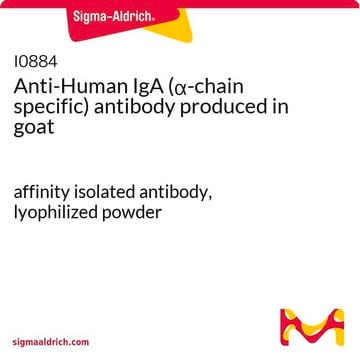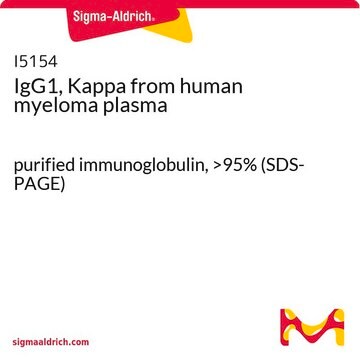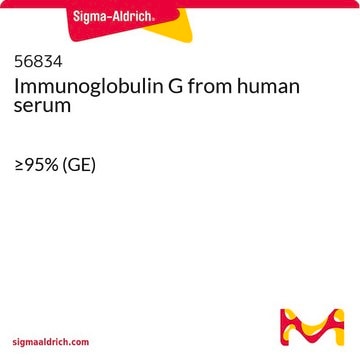I2636
IgA from human colostrum
reagent grade, buffered aqueous solution
Synonym(s):
Human IgA
Sign Into View Organizational & Contract Pricing
All Photos(1)
About This Item
Recommended Products
conjugate
unconjugated
grade
reagent grade
form
buffered aqueous solution
shipped in
dry ice
storage temp.
−20°C
target post-translational modification
unmodified
Looking for similar products? Visit Product Comparison Guide
General description
Immunoglobulin A (IgA) is the most abundant antibody isotype produced in humans. IgAs are heterogeneous and exist astwo IgA subtypes. It has the ability to form multimers by interacting with the joining (J) chain. It is present in large quantities in blood. Immunoglobulin A (IgA) antibodies protect mucosal surfaces against invading pathogens.
Application
IgA from human colostrum has been used to find out percent cross-selectivity values for lactoferrin immunosensors versus several common proteins contained in milk and saliva. It has also been used in western blotting.
IgA from human colostrum is a suitable ELISA standard used to estimate the concentrations of IgA in human B cell culture supernatants and in human blood, colostrum and cord blood samples.
Biochem/physiol Actions
IgA antibody is secretory antibody and is present abundantly in mucous linings of gastrointestinal, respiratory and genitourinary tracts, tears, colostrum and saliva. Thus secretory IgA contributes to the humoral defense mechanism against the pathogens on mucosal surfaces.
Physical form
Solution in 0.01 M Tris-HCl, 0.1 M sodium chloride, pH 8.0, containing 15 mM sodium azide
Disclaimer
Unless otherwise stated in our catalog or other company documentation accompanying the product(s), our products are intended for research use only and are not to be used for any other purpose, which includes but is not limited to, unauthorized commercial uses, in vitro diagnostic uses, ex vivo or in vivo therapeutic uses or any type of consumption or application to humans or animals.
Storage Class Code
11 - Combustible Solids
WGK
WGK 3
Flash Point(F)
Not applicable
Flash Point(C)
Not applicable
Certificates of Analysis (COA)
Search for Certificates of Analysis (COA) by entering the products Lot/Batch Number. Lot and Batch Numbers can be found on a product’s label following the words ‘Lot’ or ‘Batch’.
Already Own This Product?
Find documentation for the products that you have recently purchased in the Document Library.
Customers Also Viewed
Tithipong Plangsangmas et al.
Animals : an open access journal from MDPI, 10(1) (2020-01-23)
Salivary immunoglobulin A (sIgA) has been proposed as a potential indicator of welfare for various species, including Asian elephants, and may be related to adrenal cortisol responses. This study aimed to distinguish circadian rhythm effects on sIgA in male and
Katie L Edwards et al.
Conservation physiology, 7(1), coy077-coy077 (2019-03-25)
Additional measures of well-being would be beneficial to the management of a variety of species in human care, including elephants. Immunoglobulin A (IgA) is an immune protein associated with pathogen defense, which has been demonstrated to decrease during times of
M Raux et al.
Journal of immunological methods, 222(1-2), 111-124 (1999-02-18)
Enzyme-linked immunosorbent assays (ELISA) were developed to test, in serum and mucosal samples, total IgG, total IgA, serum albumin, and anti-gp120 MN and anti-p24 LAI IgG and IgA levels. These ELISAs were optimized according to reagents and experimental conditions. Inter-
Beom Jin Lim et al.
Yonsei medical journal, 52(4), 610-615 (2011-05-31)
Deposition of polymeric IgA1 in the kidney mesangium is the hallmark of IgA nephropathy, but the molecular mechanisms of IgA-mediated mesangial responses and inflammatory injuries remain poorly understood. We hypothesize that Toll-like receptor 4 (TLR4) is involved in IgA-induced mesangial
Danielle E Baranova et al.
Pathogens & immunity, 5(1), 89-116 (2021-06-18)
In cholera epidemics, the spread of disease can easily outpace vaccine control measures. The advent of technologies enabling the expression of recombinant proteins, including antibodies, in the milk of transgenic animals raises the prospect of developing a self-administered and cost-effective
Our team of scientists has experience in all areas of research including Life Science, Material Science, Chemical Synthesis, Chromatography, Analytical and many others.
Contact Technical Service
